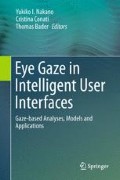Abstract
Previous studies have shown that people tend to look at a visual referent just before saying the corresponding word, and similarly, listeners look at the referent right after hearing the name of the object. We first replicated these results in an ecologically valid situation in which collaborators are engaged in an unconstrained dialogue. Secondly, building upon these findings, we developed a model, called REGARD, which monitors speech and gaze during collaboration in order to automatically detect associations between words and objects of the shared workspace. The results are very promising showing that the model is actually able to detect correctly most of the references made by the collaborators. Perspectives of applications are briefly discussed.
Access this chapter
Tax calculation will be finalised at checkout
Purchases are for personal use only
Notes
- 1.
Cross-recurrence is a general measure that quantifies the similarity or the coupling between two dynamical systems.
- 2.
Concept-maps are diagrams consisting of boxes representing concepts and labeled links representing relations between concepts.
- 3.
IHMC: http://cmap.ihmc.us/.
- 4.
- 5.
CMU-Sphinx (http://cmusphinx.sourceforge.net/html/cmusphinx.php) is an open-source general speech recognition engine developed at Carnegie Mellon University.
- 6.
“Regard” is also the French word corresponding to “gaze”.
References
Allopenna PD, Magnuson JS, Tanenhaus MK (1998) Tracking the time course of spoken word recognition using eye movements: evidence for continuous mapping models. J Mem Lang 38(4):419–439. doi:10.1006/jmla.1997.2558
Cherubini M, Nüssli M-A, Dillenbourg P (2008) Deixis and gaze in collaborative work at a distance: a computational model to detect misunderstandings. In: Proceedings of the 2008 symposium on eye tracking research and applications (ETRA’08). ACM, New York, pp 173–180
Deléglise P, Estève Y, Meignier S, Merlin T (2005) The LIUM speech transcription system: a CMU Sphinx III-based system for French broadcast news. In: Interspeech 2005
Griffin ZM (2001) Gaze durations during speech reflect word selection and phonological encoding. Cognition 82(1):B1–B14
Griffin ZM, Bock K (2000) What the eyes say about speaking. Psychol Sci 11(4):274–279
Griffin ZM, Oppenheimer DM (2006) Speakers gaze at objects while preparing intentionally inaccurate labels for them. J Exp Psychol Learn Mem Cogn 32(4):943–948. doi:10.1037/0278-7393.32.4.943
Meyer AS, Sleiderink AM, Levelt WJM (1998) Viewing and naming objects: eye movements during noun phrase production. Cognition 66(2):B25–B33. doi:10.1016/S0010-0277(98)00009-2
Nüssli M-A (2011) Dual eye-tracking methods for the study of remote collaborative problem solving. PhD thesis, École Polytechnique Fédérale de Lausanne
Richardson DC, Dale R (2005) Looking to understand: the coupling between speakers’ and listeners’ eye movements and its relationship to discourse comprehension. Cogn Sci 29(29):1045–1060
Sangin M (2009) Peer knowledge modeling in computer supported collaborative learning. PhD thesis, École Polytechnique Fédérale de Lausanne
Sangin M, Molinari G, Nüssli M-A, Dillenbourg P (2008) How learners use awareness cues about their peer’s knowledge: insights from synchronized eye-tracking data. In: ICLS, vol 2, pp 287–296
Sangin M, Molinari G, Nüssli M-A, Dillenbourg P (2011) Facilitating peer knowledge modeling: effects of a knowledge awareness tool on collaborative learning outcomes and processes. Comput Hum Behav 27(3):1059–1067. doi:10.1016/j.chb.2010.05.032
Zelinsky GJ, Murphy GL (2000) Synchronizing visual and language processing: an effect of object name length on eye movements. Psychol Sci 11(2):125–131
Acknowledgements
This work was funded by the Swiss National Science Foundation (grant #K-12K1-117909).
Author information
Authors and Affiliations
Corresponding author
Editor information
Editors and Affiliations
Appendix
Appendix
In order to allow the reader to get a general idea of the type of dialogue that occurred during the task, Tables 5.3 and 5.4 show two translated excerpts from two different dyads. The references to objects of the map have been put in quotation marks. The first excerpt (see Table 5.3) shows a dialogue centered around the objects that are drawn on the map while the second excerpt (see Table 5.4) is more conceptual with few explicit references to the objects of the concept-map.
Rights and permissions
Copyright information
© 2013 Springer-Verlag London
About this chapter
Cite this chapter
Nüssli, MA., Jermann, P., Sangin, M., Dillenbourg, P. (2013). REGARD: Remote Gaze-Aware Reference Detector. In: Nakano, Y., Conati, C., Bader, T. (eds) Eye Gaze in Intelligent User Interfaces. Springer, London. https://doi.org/10.1007/978-1-4471-4784-8_5
Download citation
DOI: https://doi.org/10.1007/978-1-4471-4784-8_5
Publisher Name: Springer, London
Print ISBN: 978-1-4471-4783-1
Online ISBN: 978-1-4471-4784-8
eBook Packages: Computer ScienceComputer Science (R0)

